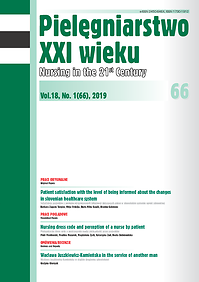Kwas foliowy – rola w organizmie, rekomendacje i znaczenie kliniczne
DOI:
https://doi.org/10.2478/pielxxiw-2019-0007Słowa kluczowe:
kwas foliowy, rekomendacje, wady wrodzone, suplementacja, ciążaAbstrakt
KWAS FOLIOWY – ROLA W ORGANIZMIE, REKOMENDACJE I ZNACZENIE KLINICZNE
Wprowadzenie. Kwas foliowy jest związkiem zaliczanym do witamin z grupy B. W organizmie podlega procesom przekształcającym jego nieaktywną postać do formy odpowiedzialnej za biologiczne efekty działania kwasu foliowego, czyli 5-metylotetrahydrofolianu (5-MTHF). Odpowiada w szczególności za procesy prawidłowej biosyntezy zasad purynowych i pirydynowych biorących udział w tworzeniu cząsteczek DNA oraz RNA. Człowiek nie syntetyzuje endogennej formy kwasu foliowego, dlatego istotna jest suplementacja tej witaminy w formie naturalnej bądź preparatów wielowitaminowych. Najwięcej kwasu foliowego znajduje się w zielonych warzywach liściastych (szpinak, groch, szparagi) oraz w podrobach (wątróbka).W szczególności właściwa podaż kwasu foliowego jest wskazana u pacjentek ciężarnych, u których obserwuje się zmniejszoną ilość kwasu foliowego z powodu wykorzystania go przez intensywnie rozwijający się płód. Zalecaną dawką kwasu foliowego w tym okresie jest 0,4 mg/dobę i dawka ta zmienia się w zależności od historii chorobowej pacjentki i jej rodziny. Przedstawiono uaktualniony stan wiedzy dotyczący roli witaminy B9 w organizmie. Przeanalizowano znaczenie jej suplementacji w szczególnych sytuacjach klinicznych.
Podsumowanie. Wiele badań wskazuje na udział kwasu foliowego w zapobieganiu wrodzonym wadom układu nerwowego, sercowo-naczyniowego oraz moczowo-płciowego. Jego niedobór zwiększa ryzyko rozwoju powikłań w przebiegu ciąży, takich jak poronienia nawracające, stan przedrzucawkowy czy krwotok poporodowy. Rekomenduje się profilaktyczną suplementację kwasem foliowym, w szczególności wśród kobiet o podwyższonym ryzyku jego niedoboru.
Bibliografia
1. Cieślik E., Kościej A. Kwas foliowy – występowanie i znaczenie. Probl Hig Epidemiol. 2012; 93(1): 1–7.
2. Bomba-Opoń D, Hirnle L, Kalinka Ji wsp. Suplementacja folianów w okresie przedkoncepcyjnym, w ciąży i połogu. Rekomendacje Polskiego Towarzystwa Ginekologów i Położników. Gin Perinat Prakt. 2017; 2, 5: 210–214.
3. Paul L, Selhub J. Interaction between excess folate and low vitamin B12 status. Mol Aspects Med. 2017; 53: 43–47.
4. National Institutes of Health. Office of Dietary Supplemensts. Folate. Fact Sheet for Health Professionals. https://ods.od.nih.gov/factsheets/Folate-HealthProfessional/. Dostęp: 25.02.2019.
5. Kerr SM, Parker SE, Mitchell AA et al. Periconceptional maternal fever, folic acid intake, and the risk for neural tube defects. Ann Epidemiol. 2017: 27(12); 777–782.
6. Putta S, Pennell PB. Management of epilepsy during pregnancy: evidence–based strategies. Future Neurol. 2015; 10 (2): 161–176.
7. Viale L, Allotey J, Cheong-See F et al. Epilepsy in pregnancy and reproductive outcomes: a systematic review and meta-analysis. Lancet. 2015; 386(10006):1845–1852.
8. Gooneratne I.K, Wimalaratna M, Ranaweera AKP et al. Contraception advice for women with epilepsy. BMJ. 2017; 357:j2010.
9. Van Gool JD, Hirche H, Lax H et al. Folic acid and primary prevention of neural tube defects: A review. Reprod Toxicol. 2018; 80:73–84.
10. Turgal M, Gumruk F, Karaagaoglu E et al. Methylenetetrahydrofolate Reductase Polymorphisms and Pregnancy Outcome. Geburtshilfe Frauenheilkde. 2018: 78(09); 871–878.
11. Servy EJ, Jacquesson-Fournols L, Cohen M et al.MTHFR isoform carriers. 5-MTHF (5-methyl tetrahydrofolate) vs folic acid: a key to pregnancy outcome: a case series. J Assist Reprod Genet. 2018: 35(8); 1431–1435.
12. Whitrow MJ., Moore VM., Rumbold AR. et al. Effect of Supplemental Folic Acid in Pregnancy on Childhood Asthma: A Prospective Birth Cohort Study. Am J Epidemiol. 2009; 170(12): 1486–1493.
13. Trivedi MK., Sharma S., Rifas-Shiman SL. Et al. Folic Acid in Pregnancy and Childhood Asthma: A US Cohort. Clin Pediatr. 2018; 57(4): 421–427.
14. Vereen S., Gebretsadik T., Johnson N. Association Between Maternal 2nd Trimester Plasma Folate Levels and Infant Bronchiolitis. Matern Child Health J. 2018; 23(2):164–172.
15. Imbard A, Benoist JF, Blom H. Neural Tube Defects, Folic Acid and Methylation. Int J Environ Res Public Health. 2013: 10(9); 4352–4389.
16. Greene NDE, Copp AJ. Neural Tube Defects. Annu Rev Neurosci. 2014: 37(1); 221–242.
17. Bagłaj M. Wady dysraficzne: wielospecjalistyczne postępowanie. Stowarzyszenie na Rzecz Dzieci z Rzadkimi Chorobami Genetycznymi i Ich Rodzin Wspólnie. http://wspolnie.org/wady-dysraficzne/. Dostęp: 25.02.2019.
18. Liu S, Joseph KS, Luo W et al. Effect of Folic Acid Food Fortification in Canada on Congenital Heart Disease Subtypes Clinical Perspective. Circulation. 2016: 134(9); 647–655.
19. Linask KK, Huhta J. Folate protection from congenital heart defects linked with canonical Wnt signaling and epigenetics. Curr Opin Pediatr. 2010: 22(5); 561–566.
20. Van Beynum IM, Kapusta L, Bakker MK et al. Protective effect of periconceptional folic acid supplements on the risk of congenital heart defects: a registry–based case–control study in the northern Netherlands. Eur Heart J. 2009: 31(4); 464–471.
21. Groen in’t Woud S, Renkema KY, Schreuder MF et al. Maternal risk factors involved in specific congenital anomalies of the kidney and urinary tract: A case–control study. Birth Defects Res A Clin Mol Teratol. 2016: 106(7);596–603.
22. Canfield MA, Collins JS, Botto LD et al. Changes in the birth prevalence of selected birth defects after grain fortification wiht folic acid in the United States: Findings from a multi-state population–based study. Birth Defects Res A Clin Mol Teratol. 2005: 73(10); 679–689.
23. Godwin KA., Sibbald B., Bedard T et al. Changes in Frequencies of Select Congenital Anomalies since the Onset of Folic Acid Fortification in a Canadian Birth Defect Registry. Can J Public Health. 2008;99(4):271-5.
Opublikowane
Numer
Dział
Licencja
Prawa autorskie (c) 2019 Autorzy

Praca jest udostępniana na licencji Creative Commons Attribution-NonCommercial-NoDerivatives 3.0 Unported License.




